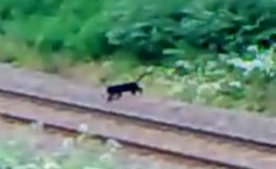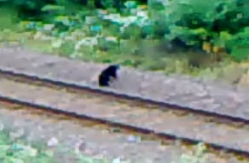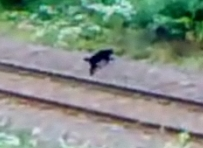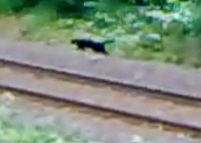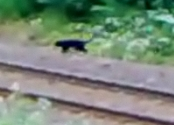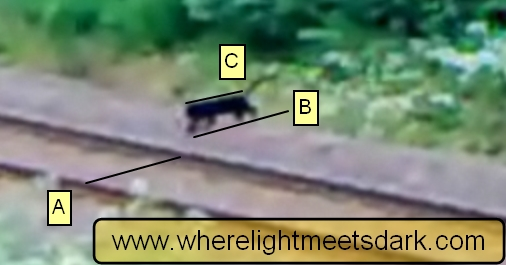Swallow panther
Photos: Chris Swallow (still frames from video footage).
Overview
On 30 June 2009 PC Chris Swallow was working in a friend's garden when he saw a large black animal on a nearby railway line. At first he assumed it was a black labrador and had concerns for its welfare as trains had been passing throughout the day.
Being a Ministry of Defence police dog handler he soon recognised that the animal did not move like a dog. Instead, he decided, it was a big cat.
After calling out to his friend to take a look, Swallow then ran to his vehicle to grab his camera phone and proceeded to take photographs and video of the cat.
Big cat researcher Shaun Stevens finds the video very exciting and notes that the rail tracks in Swallow's video are spaced 4 feet 8.5 inches apart.
Analysis of the circumstances
Perhaps the first point to note regarding this incident is that the observer's profession is in dog handling. There could be fewer people more qualified to make an accurate assessment of the size of a dog or big cat, even at a distance.
Swallow's initial impression was that the animal was a labrador. It was only after observing the animal move that he realised the behaviour of the animal did not match a dog. It is implied that his impression of the animal's size must have been equivalent to a labrador.
Pest control officer John Belshaw of the Faslane Naval Base had received reports of big cats previously and said in response to Swallow's footage that "at one point in the video it seems to walk on the railway line and a dog simply wouldn't have had the balance to do this."
Belshaw's conclusion is that he has "to say that I do not believe it is a domestic cat or a dog."
Analysis of the cat's size
Given a known width for the train tracks, this evidence is a prime candidate for estimating the size of the cat.
Although the camera's angle is oblique to the tracks, there is still one measurement that can be made with reasonable accuracy: The length of the sleepers between the rails should be approximately 4 foot 8.5 inches as quoted.
Fortunately there is just enough detail to reasonably estimate the lay of the sleepers in the photos.
Even better, in one frame the cat appears to align itself nearly parallel to the sleepers.
In the image above, the still frame has been enlarged to 200% original size. Line 'A' has been drawn parallel to the sleepers and spans the gap between rails - in other words, line 'A' correlates to 4' 8.5" "on the ground".
Line 'B' is an exact copy of line 'A' and has been positioned nearer to the cat in order to give a general impression of the cat's size. It also serves to show that the feet of the cat lie on a line nearly parallel with the railway sleepers.
Finally, line 'C' has been drawn parallel to the cat's back and from the cat's head to the base of the cat's tail. This line is not exactly parallel to lines 'A' and 'B' but it's close.
The length of line 'C' is 58.883% of the length of lines 'A' and 'B'. Therefore the length of the cat from head to the base of the tail is calculated to be approximately 33 inches, or 2' 9" (2 foot 9 inches).
Margins for error
In all fairness, the above calculation is by necessity approximate. The line lengths could have been made a few pixels longer or shorter and still appeared to represent the track width and cat size respectively. Secondly, the cat's head (one endpoint for the length we are estimating) is indistinct. Thirdly, the cat's back may not be exactly parallel with the railway sleepers, but this is probably as close as you could hope to wish for under the circumstances.
A reasonable margin of error for the above estimate seems to be that the estimate is within 10% of the real lengths.
Conclusion
To the nearest inch, the cat's size from head to base of tail is estimated to be between 30 and 37 inches, with a likely estimate of 33 inches.
It should be noted that this estimate depends on the accuracy of Stevens' claim that the tracks are known to be 4ft 8.5in.
Comparison with other cats
Citing Kindersly Dorling, Wikipedia notes that the "head and tail length" of the leopard (Panthera pardus) is typically between 49 and 65 inches. Citing the Wildlife Conservation Society, Wikipedia reports that the head and tail length of the jaguar (Panthera onca) is between 64 and 72 inches. These are the two species of "big cat" most commonly seen in melanistic (black) morphs (forms).
An analysis of a "big cat" shot by Kurt Engel in Victoria, NSW, Australia determined the head and body length of that cat to be 36 inches (91cm). DNA analysis of tissue obtained from the trophy tail of that animal determined the species to be Felis catus - the domestic cat.
Not a big cat
The Swallow cat's size is estimated to be only 67% of the smallest estimate of the smallest likely big cat species to produce a melanistic morph. (33 inches compared with 49 inches for the leopard.)
Therefore the Swallow cat is unlikely to be an adult leopard or jaguar
Noting that the estimated size of Engel's cat is also dependent on the stated size of its tail being accurate, at 36 inches, that confirmed feral domestic cat puts Swallow's cat within size limits for that species.
In conclusion, the most likely explanation for Swallow's cat, in this author's view, is that it is a large, feral domestic cat (Felis catus) measuring approximately 33 inches from head to base of tail.
The prospect of it being a juvenile leopard or jaguar, in the absence of other verified evidence of those species living in the wild in the UK, is far less likely.
References
Source article: http://news.bbc.co.uk/2/hi/uk_news/scotland/glasgow_and_west/8172064.stm
Wikipedia - leopard: http://en.wikipedia.org/wiki/Leopard#Physical_characteristics
Wikipedia - jaguar: http://en.wikipedia.org/wiki/Jaguar
